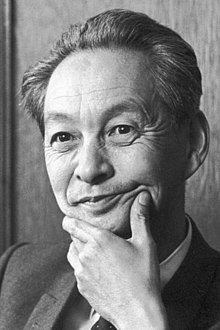Vacuum fluctuation
Vacuum fluctuations , quantum - and zero turnover , are terms that in the context of quantum field theory are used. In popular science articles, the term is often reduced to the quantum mechanical energy-time uncertainty relation or to virtual particles .
In physics, fluctuation is understood as the random change in an otherwise known constant or oscillating system variable, such as fluctuation in the earth's gravitational field . However, the vacuum fluctuation is not to be understood in this sense . The vacuum is uniform in space and time and does not change at all.

In the formulas of the quantum field theory of Werner Heisenberg and Wolfgang Pauli , infinities appear, which were resolved by renormalization by Richard Feynman and Julian Seymour Schwinger in 1948 and a little earlier during the war by Shin'ichirō Tomonaga . In connection with the resulting terms, the physicists developed the idea of clouds of virtual particles that surround the non-disturbed particles of classical theory . In the imagination, virtual particles can be reabsorbed real and immediately in a very short period of time. The resulting fluctuation in energy changes the measurable mass and charge of the particles. This fluctuation is therefore already contained in the observable particles such as electrons or photons and can never be viewed in isolation. The virtual particles therefore have no physical meaning, so the vacuum fluctuation must not be confused with the pair formation .
In the past, the Casimir effect (forces of attraction between parallel metal plates) was seen as proof that vacuum fluctuations or virtual particles could have an independent physical meaning. Robert L. Jaffe showed in 2005 that these effects can be derived from quantum-theoretical perturbation calculations without vacuum fluctuations. (The Casimir effect results from the van der Waals interaction for plates of infinite extension and conductivity.) Joseph Cugnon has also confirmed that the cause of the Casimir effect is more related to the van der Waals interaction explain is. In 2011, a team of Swedish scientists from Chalmers University of Technology detected the radiation that is typical for vacuum fluctuations when looking at the dynamic Casimir effect and thus ruled out the Van der Waals interaction as the sole cause.
In popular scientific articles vacuum fluctuation is sometimes derived from the uncertainty relation between time and energy , assuming zero-point energy , also called vacuum energy. Sometimes the impression is given that these fluctuations could trigger physical effects. Vacuum fluctuations are cited as evidence that the quantum mechanical vacuum is not “empty” in the classical sense. Vacuum fluctuations are sometimes seen as a possible explanation for the dark energy , but the calculated values differ by a factor of 10 120 .
As early as 1970, physicist Gerald T. Moore derived from quantum field theory that virtual particles that are in a vacuum can become real when they are reflected by a mirror that moves almost at the speed of light . However, this effect is more due to thermal emission. It was later also called the dynamic Casimir effect. The experimental physicist Per Delsing and colleagues from the University of Gothenburg believe that they demonstrated this effect in 2011.
According to their own statement, physicists at the University of Konstanz have directly demonstrated vacuum fluctuations. With a very short laser pulse in the range of a femtosecond , effects were measured that can supposedly only be explained with the help of vacuum fluctuations. Leitenstorfer and colleagues come to the conclusion that the observed effects were triggered by virtual photons . The mathematician Arnold Neumaier takes a critical look at this article in his popular science forum post. He emphasizes that the use of vacuum expectation values in the quantum mechanical formula used is not an indication of vacuum fluctuations, since these expectation values will appear in all calculations as long as they are carried out in a perturbative setting. In non-disruptive lattice field theoretical studies , no one saw the slightest trace of vacuum fluctuations.
literature
- Kimball Milton (Ed.): The Casimir Effect , World Scientific 2001
- Peter W. Milonni : The quantum vacuum. An introduction to quantum electrodynamics , Academic Press 1994
- Johann Rafelski , Berndt Müller : The structured vacuum - thinking about nothing. Harri Deutsch, 1985; physics.arizona.edu (PDF)
- Andreas Müller: Quantum vacuum . Astro knowledge
Individual evidence
- ^ Arnold Neumaier: The Physics of virtual particles . March 28, 2016. Accessed January 2017.
- ↑ Hendrik van Hees: Introduction to Relativistic Quantum Field Theory . P. 127 ff. February 2016. Accessed February 2017.
- ^ RL Jaffe Casimir effect and the quantum vacuum. Physical Review D, 2005, Volume 72, No. 2, p. 021301. arxiv : hep-th / 0503158
- ^ Joseph Cugnon: The Casimir Effect and the Vacuum Energy: Duality in the Physical Interpretation. In: Few-Body Systems. 53.1-2 (2012), pp. 181-188. ulg.ac.be (PDF)
- ^ P. Delsing, F. Nori, T. Duty, JR Johansson, M. Simoen: Observation of the dynamical Casimir effect in a superconducting circuit . In: Nature . tape 479 , no. 7373 , November 2011, ISSN 1476-4687 , p. 376–379 , doi : 10.1038 / nature10561 ( nature.com [accessed July 18, 2019]).
- ^ Henning Genz, Karlsruhe: Vacuum - 3.6 Fluctuations . Accessed January 2017.
- ↑ arxiv : 0712.4141
- ↑ Rüdiger Vaas: Nothing comes from nothing . January 2012. Accessed January 2017.
- ↑ Maike Pollmann: Light generated from vacuum . November 2016. Accessed January 2017.
- ↑ Gerald T. Moore: Quantum Theory of the Electromagnetic Field in a Variable-Length One-Dimensional Cavity . September 1970, bibcode : 1970JMP .... 11.2679M .
- ↑ C. Riek, DV Seletskiy, AS Moskalenko, JF Schmidt, P. Krauspe, S. Eckart, S. Eggert, G. Burkard, A. Leitenstorfer: Direct sampling of electric-field vacuum fluctuations (PDF) Retrieved January 2017.
- ↑ vacuum fluctuations . Archived from the original on January 21, 2017. Retrieved January 2017.
- ^ Arnold Neumaier: Vacuum Fluctuations in Experimental Practice . January 19, 2017. Accessed January 31, 2019.